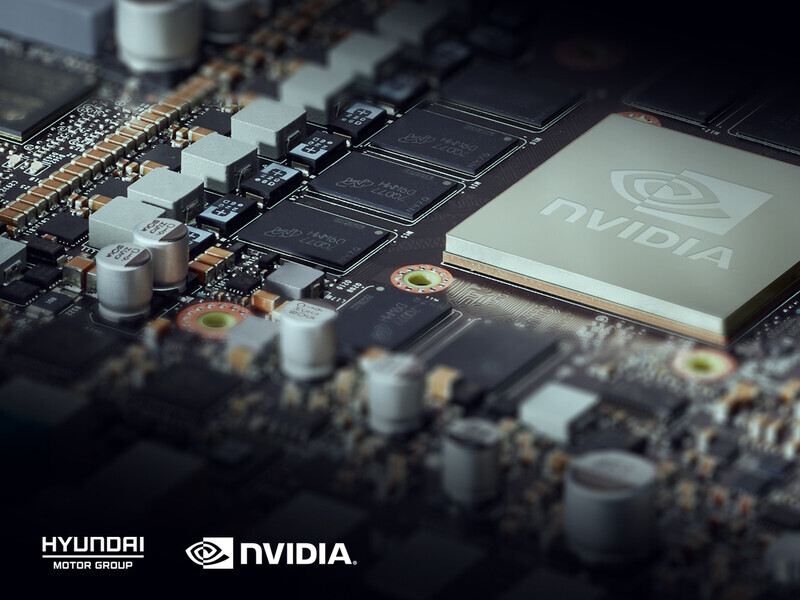hankyoreh
Links to other country sites 다른 나라 사이트 링크
Hyundai to begin mass production of connected cars equipped with Nvidia chips starting in 2022

The Hyundai Motor Group plans to begin full-scale mass production of connected cars using Nvidia chips as of 2022. This signals the arrival of a strong growth trend for the automotive semiconductor industry. Particularly relevant is the question of who will achieve dominance in the market for high-performance semiconductors, which are seen as key elements in autonomous vehicle (AV) technology.
The Hyundai Motor Group announced on Nov. 10 that it will be including connected car operating systems (OS) with NVIDIA DRIVE in all of its vehicles placed on the market from 2022 onward. NVIDIA DRIVE is a computer platform providing AV functions. Hyundai Motor’s plan is to rely on Nvidia-developed items for its semiconductor chips, while developing and providing its own software. The automaker included a connected car OS with NVIDIA DRIVE for the first time this year in its Genesis GV80 and G80 models.
The “connected car” concept refers to the optimizing of services through connections between data generated by the vehicle and external data related to traffic, the weather, and other conditions. It is seen as essential technology for achieving full-scale AV adoption.
Vehicle in 2010 required around 300 semiconductors, future AV to require at least 2,000The Hyundai Motor Group’s actions offer a good illustration of the current situation, where an AV semiconductor market landscape is taking shape in earnest. A pivotal role in this is played by high-performance semiconductors, a form of AV technology that requires the processing of enormous volumes of data. According to a report published last year by the Korea Testing Laboratory (KTL), while a single vehicle in 2010 included over 300 semiconductors, a Level 3 AV or higher would require at least 2,000. The unit price of semiconductors per vehicle is also predicted to rise rapidly from its 2018 level of US$800 (for an electric vehicle). This explains why automakers face difficulties relying simply on outsourcing.
The Hyundai Motor Group has adopted a two-track strategy, with plans to rely on external sources for high-performance semiconductors like app processors (APs), which it has difficulty developing on its own, while achieving maximum internalization for semiconductors that are relatively easy for it to develop. Four semiconductors -- related to electricity supplies, drive, sensor, and power -- are being developed by Hyundai Autron. In May, Hyundai Autron opened a lab with Hyundai Motor for the joint development of silicon carbide power semiconductors.
Other major automakers have also been speeding up their push to internalize semiconductor design. Tesla, which recently announced plans for independent battery production, is also seen as the most aggressive when it comes to semiconductors. Since last year, it has been using independently developed chips rather than Nvidia-developed ones in its Autopilot advanced driver-assistance system (ADAS). Next year, it is reportedly planning to have Taiwan’s TSMC produce a 7 nanometer chip. CEO Elon Musk claimed that Tesla had developed the “best chip in the world.” Meanwhile, traditional vehicle makers such as Volkswagen and Toyota have mainly been pursuing co-development with Nvidia and other established semiconductor companies.
By Lee Jae-yeon, staff reporter
Please direct comments or questions to [english@hani.co.kr]

Editorial・opinion
![[Column] The state is back — but is it in business? [Column] The state is back — but is it in business?](https://flexible.img.hani.co.kr/flexible/normal/500/300/imgdb/original/2024/0506/8217149564092725.jpg) [Column] The state is back — but is it in business?
[Column] The state is back — but is it in business?![[Column] Life on our Trisolaris [Column] Life on our Trisolaris](https://flexible.img.hani.co.kr/flexible/normal/500/300/imgdb/original/2024/0505/4817148682278544.jpg) [Column] Life on our Trisolaris
[Column] Life on our Trisolaris- [Editorial] Penalties for airing allegations against Korea’s first lady endanger free press
- [Editorial] Yoon must halt procurement of SM-3 interceptor missiles
- [Guest essay] Maybe Korea’s rapid population decline is an opportunity, not a crisis
- [Column] Can Yoon steer diplomacy with Russia, China back on track?
- [Column] Season 2 of special prosecutor probe may be coming to Korea soon
- [Column] Park Geun-hye déjà vu in Yoon Suk-yeol
- [Editorial] New weight of N. Korea’s nuclear threats makes dialogue all the more urgent
- [Guest essay] The real reason Korea’s new right wants to dub Rhee a founding father
Most viewed articles
- 1[Column] Why Korea’s hard right is fated to lose
- 2Amid US-China clash, Korea must remember its failures in the 19th century, advises scholar
- 3[Column] The state is back — but is it in business?
- 460% of young Koreans see no need to have kids after marriage
- 5Presidential office warns of veto in response to opposition passing special counsel probe act
- 6Japan says it’s not pressuring Naver to sell Line, but Korean insiders say otherwise
- 7[Editorial] Stagnant youth employment poses serious issues for Korea’s future
- 8[Guest essay] Maybe Korea’s rapid population decline is an opportunity, not a crisis
- 9OECD upgrades Korea’s growth forecast from 2.2% to 2.6%
- 10Hybe-Ador dispute shines light on pervasive issues behind K-pop’s tidy facade